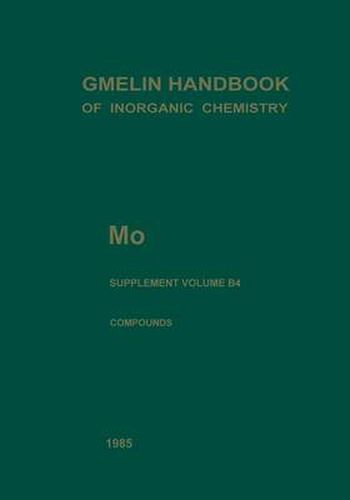Readings Newsletter
Become a Readings Member to make your shopping experience even easier.
Sign in or sign up for free!
You’re not far away from qualifying for FREE standard shipping within Australia
You’ve qualified for FREE standard shipping within Australia
The cart is loading…






This title is printed to order. This book may have been self-published. If so, we cannot guarantee the quality of the content. In the main most books will have gone through the editing process however some may not. We therefore suggest that you be aware of this before ordering this book. If in doubt check either the author or publisher’s details as we are unable to accept any returns unless they are faulty. Please contact us if you have any questions.
This volume contains the hydrous oxo compounds of the metals Sb to Cr (System Nos. 18 to 52) with molybdenum. (The corresponding anhydrous compounds have been described in the volumes Molybdan Erg.-Bd. B 1 and B 2.) With these metals, molybdenum forms monomolyb- dates, isopolymolybdates, peroxomolybdates, and molybdometalates. Antimony forms only the compound H3SbM01204o’ n H0 and with bismuth no hydrous oxo 2 compounds are known. More than half the volume describes the monomolybdates, isopolymolybdates, and peroxo- molybdates of the alkali and alkaline earth metals, including ammonium and organic cations. First, a detailed review on the structures, spectra, and other properties of the various iso- polymolybdate types is given. It also contains a comprehensive description on photochromism, a property characteristic of many of the organic ammonium polymolybdates. Then follows the description of the individual alkali compounds. The large group of molybdates with organic cations is placed after the caesium molybdates. The photochromism and the photogalvanic effect are investigated at length for (i-C3H7NH3)6[M07024)‘ 3 H0. The alkaline earth molybdates 2 are treated briefly compared with the alkali molybdates, e. g., no new data are available on beryllium molybdates.
$9.00 standard shipping within Australia
FREE standard shipping within Australia for orders over $100.00
Express & International shipping calculated at checkout
This title is printed to order. This book may have been self-published. If so, we cannot guarantee the quality of the content. In the main most books will have gone through the editing process however some may not. We therefore suggest that you be aware of this before ordering this book. If in doubt check either the author or publisher’s details as we are unable to accept any returns unless they are faulty. Please contact us if you have any questions.
This volume contains the hydrous oxo compounds of the metals Sb to Cr (System Nos. 18 to 52) with molybdenum. (The corresponding anhydrous compounds have been described in the volumes Molybdan Erg.-Bd. B 1 and B 2.) With these metals, molybdenum forms monomolyb- dates, isopolymolybdates, peroxomolybdates, and molybdometalates. Antimony forms only the compound H3SbM01204o’ n H0 and with bismuth no hydrous oxo 2 compounds are known. More than half the volume describes the monomolybdates, isopolymolybdates, and peroxo- molybdates of the alkali and alkaline earth metals, including ammonium and organic cations. First, a detailed review on the structures, spectra, and other properties of the various iso- polymolybdate types is given. It also contains a comprehensive description on photochromism, a property characteristic of many of the organic ammonium polymolybdates. Then follows the description of the individual alkali compounds. The large group of molybdates with organic cations is placed after the caesium molybdates. The photochromism and the photogalvanic effect are investigated at length for (i-C3H7NH3)6[M07024)‘ 3 H0. The alkaline earth molybdates 2 are treated briefly compared with the alkali molybdates, e. g., no new data are available on beryllium molybdates.